“Within the human cortex crouches an impulse to build something huge.” – Kathryn Gabriel
Preface: For those of you who are NOT Stewart Brand, and are wondering how this page came to be…
Sometime in 2022 I realized that Stewart had become a kind of unwitting mentor to me. I’d been taking his published thought processes on board for over a decade, and they really opened my mind to the possibilities of actually planning for and creating a happy and healthy future for the human species in harmony with our planet. Wow. You mean we might not just survive this craziness, but actually thrive? Sign me up!
Eventually I thought, why not write him a letter? He may never see it, but just the process of doing it would help me articulate and understand why I was motivated to do what I’m doing, and also help me tighten my focus, which is something I’d really need to do if I were going to pull off these rather large projects that I’m inspired to make.
So I wrote the letter you’ll read below. Early in 2023 I sent a much shorter letter to his physical address in Sausalito, with a few stickers and odds and ends in the envelope to see if I could get his attention, and a link to this page.
Has he seen it? Will he ever see it? I have no idea! But it was such a good exercise just to write it all out. If he’s seen it, will he ever answer the questions I ask at the end? I don’t know, but just by posing them I’ve been able to understand myself better and start to answer them for myself. I recommend it to anyone with a similar unwitting mentor. Even if you never send it, it’s still great fun and very useful, and something to check back on as your direction evolves.
***
Thanks for checking this out! I’m glad you’re here. This is the long version. To keep it from being even longer I’ve linked some stuff out, but it’s all there if you’re interested.
First, that connection with Matt Winkler— I’m an international adoptee (born and adopted in the Bahamas), and when I tested my DNA with 23andMe back in 2009 he turned up as as second cousin match. Long story short I tracked him down, sent him my story, and he shared his mother’s genealogy with me, which enabled me to find and successfully reunite with my biological family, who all turn out to be from New Mexico. Matt’s kindness has been incredibly influential in my life and I owe him a debt I don’t know how I could begin to repay.
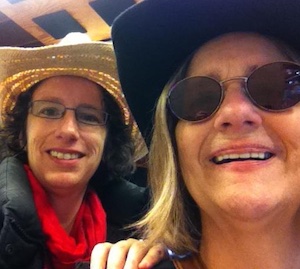
“You can’t change the way people think, all you can do is give them a tool, the use of which will change their thinking.”
Back in 2010 when I found the Long Now, it felt as if I’d been struck by lightning. The sheer audacity of the Clock blew my mind wide open. I’ve been a “stainless steel” member (# 2755) ever since. Ever since I could hold a crayon and draw on a wall I’ve been making art, but I really cut my teeth on designing and building participatory structural art for Burning Man, which I started doing in 2007 and stopped doing in 2017.
I grew up between three different cultures, and because of this a big part of what drives me is figuring out how to create things that are universal, that reach across culture and language and age and race and politics and education, and that are accessible to everyone regardless of identity. Things that call for participation, and most importantly things that are fun to do and be a part of. The combination of Burning Man and Long Now as influences has also really made me want to build things that endure. Burning Man is great and all, but there’s only so much shit you can set on fire.
I’m a 4:00 a.m. struck-by-inspiration type. I’ve been getting downloads for years, but it’s only recently that I began to see that my muses came in two categories—SPACE and TIME. Each of these trajectories has a Gigantic Enduring Project at the end of it, both of which I’d like to see built if I have enough years left in my life. You’re basically the Yoda of long-term thinking, and I’d love some of your wisdom if you might share it with me—I have some questions for you at the end of this document.
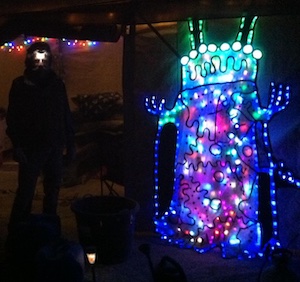
All of these future projects will have to build community, and be crowdfunded and conceptually self-supporting. If they fail, it’ll be because it wasn’t the right time, or they weren’t good enough ideas yet. People have to want to do these things, to draw some kind of useful identity from them, and to support them out of love and enthusiasm—particularly and essentially the people who will be living locally near them. Participation is fundamental. Also, each trajectory is highly iterative. I’ve been evolving variations of each concept, and I find joy in this repetition. The end goals may turn out to be entirely different from what I think they are now, but they’re serving as beacons, and that’s good enough.
There’s something important in the physical artifact. People spend so much time in the virtual these days, but the novelty is wearing thin. I am reading a giant surge of upcoming need to re-engage the physical. People are realizing the problems they develop when they forget they have bodies.

SPACE
Here’s little me, with my nose pressed up against the window of an airplane at 35,000 feet, fascinated with the patterns of the planet below, but there’s only two kinds of shape: those of nature, and the practical shapes that humans build: industry, civilization, and agriculture. I see a wonderful braided river basin. I see center point irrigation farming. I see a city, all gridded concrete. But none of this involves me. I didn’t make the river flow, I’m not a farmer, and I didn’t build the city.
What happens if we take agency over the aesthetic of these shapes on a scale that engages the overview? Voilà, geoglyphs.
We’ve made plenty of those already. The Nazca plain, the chalk figures of Britain. Here in Utah we paint giant letters on mountainsides. Out of all geoglyphs, the White Horse of Uffington fascinates me most. It’s almost hard to comprehend that the locals there have been weeding and maintaining this figure for three millennia, with no continuity of culture or religion—just because it was fun, and it was “their thing.”
But how do you take a geoglyph and make it interactive, more than just a once-a-year weeding? How do you engage people a little more actively? Well, how about turning it into a labyrinth? Make it something that’s maintained in part by the application of people’s feet to the planet?
We’ve been drawing and building labyrinths for thousands of years. This idea of the unicursal meditative path has endured because it’s a very good idea.
Also, people love secular pilgrimage sites. I live within reasonable driving distance of Smithson’s Spiral Jetty and I have been there many times, and never once had the place to myself—even in the middle of the day, middle of the work week—if there’s decent weather, people are at the Jetty, though it’s a long haul over dirt roads to get to.
I started designing temporary labyrinths years ago, and I’ve built quite a few that I had to remove at the end of an event, or that would be washed away the next time the water rose.
Finally in 2022 a small group of us got to create a more permanent one I designed on an acre of land in Dubois, Wyoming: the Byrd Draw labyrinth. It needs some improvement so we’ll go back in summer 2023 to finish it up, but if Google Earth updated their aerials before winter it might already be visible there.
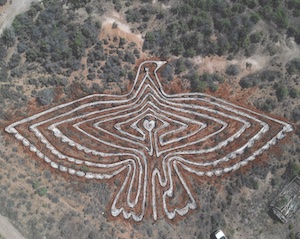
The Gigantic Enduring Project at the end of this trajectory is the Lady Eight, a walkable double-loop geoglyph with a path of two miles folded into a half-mile long design that I originally created for a tract of sage desert on the north side of the salt flats here. Our contract for that fell through but the concept has endured, and I intend to see her built one day. Will she endure for 3,000 years? Who knows? But it’s fun to think about.
There will be many other less ambitious labyrinths and geoglyphs built before this final project. I’m particularly interested in building on ag land that needs rehabbing, and creating designs that will help with that rehab. My husband Trent is a desert ecologist and together we’re researching plans to blend ecological reclamation with participatory art.
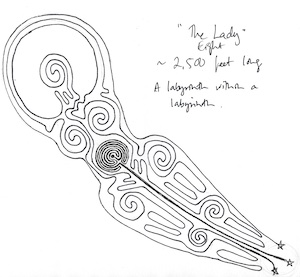
TIME
I grew up partly in the Bahamas, and when I was a small child there were no rocks around me that were not limestone, and no natural substances harder than coral or shell. We’d fly to my adoptive father’s family home in Scotland in summer and I’d pick up igneous and metamorphic river rocks and pack them home in my luggage. Bahamian limestone is so friable you can crush it with a regular claw hammer. I was fascinated by these foreign stones that were so hard the hammer bounced off, and yet had obviously been shaped by tumbling in a river. How long had that taken? And how old were they even before they’d ended up in the river?
Holding a river stone in my hand gave me the first inklings of Deep Time.
A little later, we moved to the Isle of Man, and I was thrilled to be surrounded by proper Geology. But I was a socially awkward kid (only child, and just been moved between cultures) and rocks aren’t very interactive. So I came up with this project where I would interview my classmates with a series of trivial questions (what’s your favorite color? who’s your celebrity crush?) and kept a little binder full of the answers. My classmates loved it. There was this piece of how to get people excited to participate that started right then.
When I went to Burning Man in 2007 I realized I had found My People (at least for a little while).
I spent the next decade designing and building participatory art for the Burn, and learning how to (and how not to) create and manage teams of volunteers. How to engage people and make them feel integral to the project, and how to provide identity. The problem, eventually, became the ephemeral nature of the Burn.
It gets old, always leaving no trace.
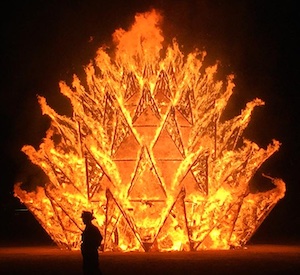
A pivotal moment for me was the Temple burn in 2013. The altar was a giant inuksuk made of black basalt, designed by Jael LaFemina (who I later enjoyed getting to know when he came to Utah to help us with our own Temple concepts a few years later). The altar was gorgeous, but when the Temple was fired it spalled explosively. Jael said that some of the shrapnel flew over a hundred yards. Consuming structural fire and stone…perhaps not a great mix. Stone wants to endure.
Life’s interventions took me out of the Burning Man loop in 2017, but I kept working on my own, much smaller projects. I took my participatory art practice into the local Salt Lake scene. I made “tag hanger” pieces for the Illuminate festival of lights in 2017 and 2018, and then started creating participatory rooms for the Dreamscapes installation art experience in 2019, 2020, and 2021. I developed my understanding of the importance of the prompt when you’re engaging the public in this sort of art. With a good prompt, you can evoke the wildest cosmic wisdom from thousands of anonymous strangers. Without one, you get drawings of penises. The two aren’t mutually exclusive, but there’s a limit to the wisdom of the wild phallus.
Even though we weren’t setting our art on fire for Dreamscapes, the installation kept having to move and be redone, and I kept coming back to the concepts of stone, and deep time, and how to create a project that would involve people and be fun to do, but would also endure. This is where the Lady of the West Desert comes in:
A giant sculpture of a seated cross-legged woman. Tough black basalt, like Jael’s inuksuk that didn’t want to die in the fire. She’s too big to carve from a single stone, so she’d have to be constructed of multiple slabs. Dry laid mortise and tenon, so there’s no mortar to weather out. Faced with a mosaic of tens of thousands of vitreously fired stoneware tiles, each one engraved with a message from a participant. Let people send messages ten thousand or more years into the future…
Build her next to one of the many sedimentary cliffs we have here in the Great Basin. If she gets maintained for ten millennia, then great! If she gets forgotten, the silt will eventually cover her, preserving her for who knows how much longer. The tiles will weather off, but get covered with silt as well, and nothing lasts like fired ceramic. Messages preserved. We build Future Archaeology…on purpose.
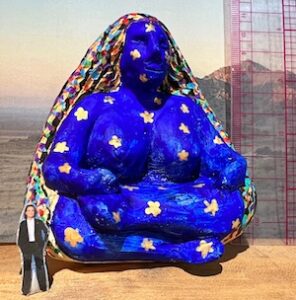
The next steps for me are, basically, keep building, and keep my eyes open for places where my work wants to go. There are opportunities out there, maybe on disused ag land, maybe in some other liminal spaces, where labyrinths and geoglyphs want to go. I’m creating a tool to help me draw large temporary glyphs on the salt flats and alkaline playas out here in Utah, to hone my surveying skills. I’ll keep building the tag hangers, engaging people in participatory art, and working on the prompts. And I’m being called to teach–people want and need to know how to build big art out of garbage, and I’m going to show them.
***
I know I have the raw basics of how to keep moving towards these two Gigantic Enduring Projects, but it’s a lot to get my arms around. I’d appreciate your thoughts:
Do you have any general advice for me about these projects? Do they seem like fun to you?
If you had 80 more years of life what would you like to accomplish?
How do you balance inspiration vs. practicability?
What’s been your beacon through the difficult times?
How do you know whether an idea you have is viable or not? Is there anything you’ve conceived that you realized wasn’t maybe a great idea to unleash on the general public, and if so, what gave you the clue?
Is there anything you’d do differently if you could do it over again?
How do you deal with attention?
How do you keep your sense of humor?
And what’s your favorite color, and your celebrity crush? 🙂
Sincerely,
Alice Bain Toler
801 573 1399
albain@gmail.com
1525 E. Redondo Ave.
Salt Lake City, UT 84105